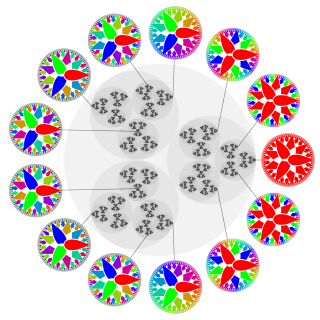Statement
The first formula is
The second is
In mathematics, Siegel's identity refers to one of two formulae that are used in the resolution of Diophantine equations.
The first formula is
The second is
The identities are used in translating Diophantine problems connected with integral points on hyperelliptic curves into S-unit equations.

In mathematics, a Diophantine equation is an equation, typically a polynomial equation in two or more unknowns with integer coefficients, for which only integer solutions are of interest. A linear Diophantine equation equates to a constant the sum of two or more monomials, each of degree one. An exponential Diophantine equation is one in which unknowns can appear in exponents.

In number theory, the study of Diophantine approximation deals with the approximation of real numbers by rational numbers. It is named after Diophantus of Alexandria.

In mathematics, p-adic analysis is a branch of number theory that deals with the mathematical analysis of functions of p-adic numbers.
In the mathematical field of complex analysis, Nevanlinna theory is part of the theory of meromorphic functions. It was devised in 1925, by Rolf Nevanlinna. Hermann Weyl called it "one of the few great mathematical events of (the twentieth) century." The theory describes the asymptotic distribution of solutions of the equation f(z) = a, as a varies. A fundamental tool is the Nevanlinna characteristic T(r, f) which measures the rate of growth of a meromorphic function.
In mathematics, Diophantine geometry is the study of Diophantine equations by means of powerful methods in algebraic geometry. By the 20th century it became clear for some mathematicians that methods of algebraic geometry are ideal tools to study these equations. Diophantine geometry is part of the broader field of arithmetic geometry.
In mathematics, complex multiplication (CM) is the theory of elliptic curves E that have an endomorphism ring larger than the integers. Put another way, it contains the theory of elliptic functions with extra symmetries, such as are visible when the period lattice is the Gaussian integer lattice or Eisenstein integer lattice.
In mathematics, Roth's theorem or Thue–Siegel–Roth theorem is a fundamental result in diophantine approximation to algebraic numbers. It is of a qualitative type, stating that algebraic numbers cannot have many rational number approximations that are 'very good'. Over half a century, the meaning of very good here was refined by a number of mathematicians, starting with Joseph Liouville in 1844 and continuing with work of Axel Thue (1909), Carl Ludwig Siegel (1921), Freeman Dyson (1947), and Klaus Roth (1955).

Serge Lang was a French-American mathematician and activist who taught at Yale University for most of his career. He is known for his work in number theory and for his mathematics textbooks, including the influential Algebra. He received the Frank Nelson Cole Prize in 1960 and was a member of the Bourbaki group.
In mathematics, a field F is called quasi-algebraically closed if every non-constant homogeneous polynomial P over F has a non-trivial zero provided the number of its variables is more than its degree. The idea of quasi-algebraically closed fields was investigated by C. C. Tsen, a student of Emmy Noether, in a 1936 paper ; and later by Serge Lang in his 1951 Princeton University dissertation and in his 1952 paper. The idea itself is attributed to Lang's advisor Emil Artin.
This is a glossary of arithmetic and diophantine geometry in mathematics, areas growing out of the traditional study of Diophantine equations to encompass large parts of number theory and algebraic geometry. Much of the theory is in the form of proposed conjectures, which can be related at various levels of generality.
A height function is a function that quantifies the complexity of mathematical objects. In Diophantine geometry, height functions quantify the size of solutions to Diophantine equations and are typically functions from a set of points on algebraic varieties to the real numbers.
In mathematics, Siegel's theorem on integral points states that for a smooth algebraic curve C of genus g defined over a number field K, presented in affine space in a given coordinate system, there are only finitely many points on C with coordinates in the ring of integers O of K, provided g > 0.
In mathematics, the subspace theorem says that points of small height in projective space lie in a finite number of hyperplanes. It is a result obtained by Wolfgang M. Schmidt (1972).
In mathematics, the Goormaghtigh conjecture is a conjecture in number theory named for the Belgian mathematician René Goormaghtigh. The conjecture is that the only non-trivial integer solutions of the exponential Diophantine equation
In mathematics, the capacity of a set in Euclidean space is a measure of the "size" of that set. Unlike, say, Lebesgue measure, which measures a set's volume or physical extent, capacity is a mathematical analogue of a set's ability to hold electrical charge. More precisely, it is the capacitance of the set: the total charge a set can hold while maintaining a given potential energy. The potential energy is computed with respect to an idealized ground at infinity for the harmonic or Newtonian capacity, and with respect to a surface for the condenser capacity.
In mathematics, Arakelov theory is an approach to Diophantine geometry, named for Suren Arakelov. It is used to study Diophantine equations in higher dimensions.
In mathematics, in the field of algebraic number theory, a modulus is a formal product of places of a global field. It is used to encode ramification data for abelian extensions of a global field.
In mathematics, in the field of algebraic number theory, an S-unit generalises the idea of unit of the ring of integers of the field. Many of the results which hold for units are also valid for S-units.
In mathematics, a superelliptic curve is an algebraic curve defined by an equation of the form
In algebra and number theory, a distribution is a function on a system of finite sets into an abelian group which is analogous to an integral: it is thus the algebraic analogue of a distribution in the sense of generalised function.